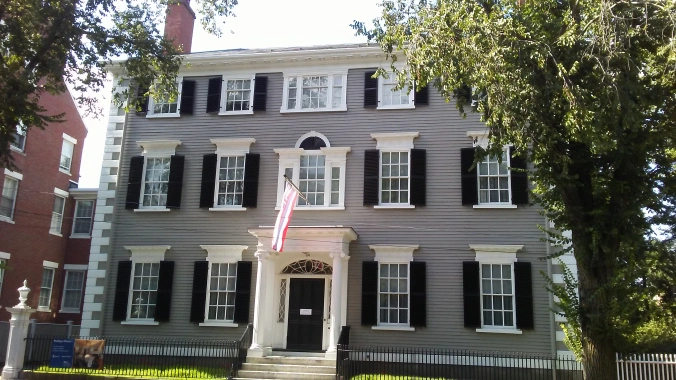
Flashback to last October, on Massachusetts’ North Shore: Ipswich, not far from the New Hampshire border, is a gem of natural and historical sites. We drove (approximately a two hour drive from Boston) with the intention of visiting the famously beautiful Castle Hill on the Crane Estate. However, when we arrived, the gate was shut. The park was closed in order to clean up trees that had fallen in a recent wind storm. But we were determined to still enjoy Ipswich, and we most certainly did.

Looking Back Towards the Beach Parking Lot 
The View Along the Beach
A park employee, advised us to drive to the nearby – and apparently popular – Crane Beach. The day was sunny, windy, and bone-chilling, but the beach was magnificent. Sand dunes speckled with brush spilled toward the water, where the water thrashed in the wind. Islands and promontories were visible, and marshes spread out on our right.
If we peered closely at the hill behind us, the mansion was just visible in a clearing of the trees. So, other than opulent beauty, what makes the Crane Estate such a cool place to visit? First, there’s a wonderful beach nearby, but the Trustees (the organization in charge), list several other reasons.
Fun Fact: the Crane Estate was used for scenes of Europe in the 2019 movie, Little Women.

To start, Castle Hill and Castle Neck were first owned by John Winthrop, the first governor of Massachusetts, beginning in 1637. Two centuries later, the estate was bought by the Brown family. They added roadways and planned plantings to the property. They also renovated what was a farmhouse into the so-called “cottage.”
But in 1910, Richard T. Crane Jr. purchased the land and determined to change it dramatically. Crane was a wealthy industrialist from Chicago, who owned a company manufacturing valves, pumps, and bathroom pieces. He used his wealth extravagantly. The property was landscaped, and even included a completely-functioning farm.
The most striking of the estate’s new features was the house. At first, the Cranes built an Italian-style villa, which was finished in 1912. But they soon changed their minds, and had an English-style mansion constructed in its place! With 59-rooms, it must be impressive.
However, even though we didn’t get a chance to view this monstrous palace up close, now it’s just an excuse to go back. After our fun at Crane beach, it was time for lunch, so we drove into the downtown of Ipswich.

The Town Hall 
The Visitor Center
We elected to dine at the Heart and Soul Cafe, a warm, tasty little restaurant right in the center of town. Once we had filled up on a delicious salad, pancakes, and a burger, we set out to walk around. We had passed by a tiny old bridge, visitor center, museums, and cute shops. Unfortunately, I didn’t snap a photo of the streets downtown, but you’ll have to believe me that it was a perfect example of a quaint, bustling New England town.
Everywhere there were signposts and plaques revealing the history of the town. The Visitor Center had some great signs about the Essex Coastal Scenic Byway, which is huge, with a lot of places to discover. Zoom in on the photos below to see for yourself 🙂


The Choate Bridge, originally completed in 1764, and a small dam crossed over the Ipswich River, which runs right by the downtown. There was also a fish ladder nearby.

View from the Bridge 
A pamphlet we picked up at the Visitor Center listed all the First Period (before 1725) Homes in Ipswich. A great idea! Though designed to be a walking guide and map, we used it to drive past a bunch of houses before we headed home. This one town has 60 First Period Homes! And there are 46 listed on the map.
We briefly walked around the John Whipple House. But it was closed at the moment, along with the Ipswich Museum, which lay right across the street. Judging from their website however, I’m sure they’d both be interesting to go inside.

A First Period Home 
The Ipswich Museum 
The John Whipple House
So. I most definitely would like to return to Ipswich, and I hope you’d like to go too. There’s so much more that we didn’t even get to last time. I’m sure you could make a very full day out of everything. And even if you can’t – or don’t want to – go to the Castle Hill on the Crane Estate, there’s plenty to do that is fun and doesn’t even cost a penny.
Castle Hill on the Crane Estate | Ipswich, MA | The Trustees
Experience the grandeur of a seaside estate and its marvelously landscaped grounds, notable for a broad, undulating lawn running down to the shore. What makes Castle Hill a special place? Centuries before becoming a grand summer estate owned by one of America’s wealthiest families, Castle Hill was well known by Native Americans, who called the area Agawam, referring to its rich fishery.
IPSWICH MUSEUM | Ipswich Museum | Long and Rich History of Ipswich
The Ipswich Museum offers an array of exciting lectures, exhibits and classes that are open to the public. Check back throughout the year for the most up to date list of events.
